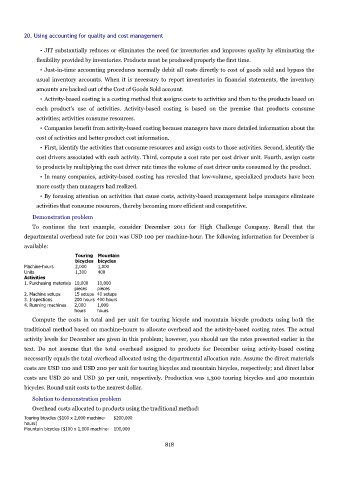Page 817 - Accounting Principles (A Business Perspective)
P. 817
20. Using accounting for quality and cost management
• JIT substantially reduces or eliminates the need for inventories and improves quality by eliminating the
flexibility provided by inventories. Products must be produced properly the first time.
• Just-in-time accounting procedures normally debit all costs directly to cost of goods sold and bypass the
usual inventory accounts. When it is necessary to report inventories in financial statements, the inventory
amounts are backed out of the Cost of Goods Sold account.
• Activity-based costing is a costing method that assigns costs to activities and then to the products based on
each product's use of activities. Activity-based costing is based on the premise that products consume
activities; activities consume resources.
• Companies benefit from activity-based costing because managers have more detailed information about the
cost of activities and better product cost information.
• First, identify the activities that consume resources and assign costs to those activities. Second, identify the
cost drivers associated with each activity. Third, compute a cost rate per cost driver unit. Fourth, assign costs
to products by multiplying the cost driver rate times the volume of cost driver units consumed by the product.
• In many companies, activity-based costing has revealed that low-volume, specialized products have been
more costly than managers had realized.
• By focusing attention on activities that cause costs, activity-based management helps managers eliminate
activities that consume resources, thereby becoming more efficient and competitive.
Demonstration problem
To continue the text example, consider December 2011 for High Challenge Company. Recall that the
departmental overhead rate for 2011 was USD 100 per machine-hour. The following information for December is
available:
Touring Mountain
bicycles bicycles
Machine-hours 2,000 1,000
Units 1,300 400
Activities
1. Purchasing materials 10,000 10,000
pieces pieces
2. Machine setups 15 setups 40 setups
3. Inspections 200 hours 400 hours
4. Running machines 2,000 1,000
hours hours
Compute the costs in total and per unit for touring bicycle and mountain bicycle products using both the
traditional method based on machine-hours to allocate overhead and the activity-based costing rates. The actual
activity levels for December are given in this problem; however, you should use the rates presented earlier in the
text. Do not assume that the total overhead assigned to products for December using activity-based costing
necessarily equals the total overhead allocated using the departmental allocation rate. Assume the direct materials
costs are USD 100 and USD 200 per unit for touring bicycles and mountain bicycles, respectively; and direct labor
costs are USD 20 and USD 30 per unit, respectively. Production was 1,300 touring bicycles and 400 mountain
bicycles. Round unit costs to the nearest dollar.
Solution to demonstration problem
Overhead costs allocated to products using the traditional method:
Touring bicycles ($100 x 2,000 machine- $200,000
hours)
Mountain bicycles ($100 x 1,000 machine- 100,000
818

